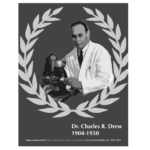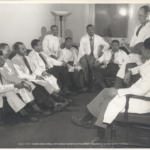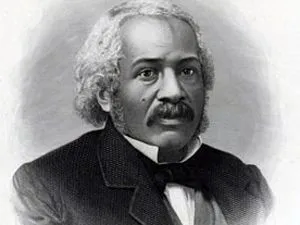Every February, our country celebrates Black History Month by honoring the contributions that African Americans have made throughout history, while also recognizing that the fight for racial justice continues to this day. This year’s theme for Black History Month is Black Health and Wellness.
James McCune Smith, MD (1813-1865)
In 1837 James McCune Smith was the first African American to receive a medical degree, at Glasgow University in Scotland. Smith obtained three university degrees, a Bachelor of Arts, Masters and Doctorate in Medicine.
By 1838 Smith later ran a medical practice and pharmacy, in New York City. Where he treated interracial patients. Eventually owning and operating two pharmacies, where he practiced medicine for 25 years.
Not only is Smith remembered for his successful work as a physician, but he was also an advocate for education, slavery, and racism. He published articles in U.S. medical journals and was one of the nation’s leading abolitionists.
James McCune Smith passed away at the age of 52 on November 17, 1865.
Source: University of Glassgow
Dr. Charles R. Drew (1904-1950)
Pioneer of Plasma and Blood Banking; Surgeon, Professor, Inventor
In August of 1939, Dr. Charles R. Drew and Dr. John Scudder were given permission with appropriate funding to conduct an experiment. This experiment would be held at the Presbyterian Hospital in New York and run for seven months. The doctors embarked on the first ever blood bank, creating and organizing the process and protocols for blood donation, not knowing that their efforts would save countless lives. It would also serve as Dr. Drew’s topic for dissertation, “Blood Bank,” earning him his Doctorate of Medical Science degree in June of 1940.
 Amid the trial blood bank, WWII was taking place and European countries were struggling to survive the wrath of the Germans. Great Britain, under duress from Germany, reached out for help—asking for medical relief. This relief was provided to them by the U.S. in an operation called “Blood for Britain” and Dr. Drew was recruited to oversee the program. Over the course of two years, Blood for Britain had collected 14,556 blood donations and 5,000 liters of plasma saline solution and shipped to England via the Red Cross.
Amid the trial blood bank, WWII was taking place and European countries were struggling to survive the wrath of the Germans. Great Britain, under duress from Germany, reached out for help—asking for medical relief. This relief was provided to them by the U.S. in an operation called “Blood for Britain” and Dr. Drew was recruited to oversee the program. Over the course of two years, Blood for Britain had collected 14,556 blood donations and 5,000 liters of plasma saline solution and shipped to England via the Red Cross.
Dr. Drew’s efforts did not go unnoticed. Upon completing the blueprints for Blood for Britain he returned home but his expertise was still needed, and the Red Cross reached out to him to run a pilot program in New York focused on the mass production of dried plasma. While at the Red Cross he acted as the Assistant Director of the program but would end up resigning. There is no proof, but it is thought that Dr. Drew gave up his post because of a Red Cross policy that required blood donations to be segregated by race. He has been quoted,
“It is fundamentally wrong for any great nation to willfully discriminate against such a large group of its people… One can say quite truthfully that on the battlefields nobody is very interested in where the plasma comes from when they are hurt… It is unfortunate that such a worthwhile and scientific bit of work should have been hampered by such stupidity.”
 After leaving the Red Cross he went back to Howard University where he would live out his life’s true passion of beinga surgeon and a professor of young African American medical students. He also continued to speak out against racism and exclusion by petitioning the American Medical Association (AMA) and others to reform their policies and allow Black Americans to become members.
After leaving the Red Cross he went back to Howard University where he would live out his life’s true passion of beinga surgeon and a professor of young African American medical students. He also continued to speak out against racism and exclusion by petitioning the American Medical Association (AMA) and others to reform their policies and allow Black Americans to become members.
Over the course of his life, Dr. Drew received many awards and honors: E.S. Jones Award for Research in Medical Science from the John A. Andrew Clinic in Tuskegee, AL (1942), Appointment to the American-Soviet Committee on Science (1943), Spingarn Medal from the NAACP (1944), Honorary Doctorates from Virginia State College (1945) and Amherst College (1947), and Election to the International College of Surgeons (1946).
Despite being faced with oppression, objectification, and exclusion, Dr. Drew kept his eye on the true prize which was the honest love of his people and the miracle of human life. Dr. Charles R Drew passed away at the age of 45 on April 1, 1950.
“. . . So much of our energy is spent in overcoming the constricting environment in which we live that little energy is left for creating new ideas or things. Whenever, however, one breaks out of this rather high-walled prison of the “Negro problem” by virtue of some worthwhile contribution, not only is he himself allowed more freedom, but part of the wall crumbles. And so it should be the aim of every student in science to knock down at least one or two bricks of that wall by virtue of his own accomplishment.”
– Charles R. Drew to Mrs. J. F. Bates, a Fort Worth, Texas schoolteacher, January 27, 1947
The Charles R. Drew Papers, 1941-1950. “My Chief Interest Was and Is Surgery” – Howard University. Retrieved from National Library of Medicine. Profiles in Science. 02-16-2022. https://profiles.nlm.nih.gov/spotlight/bg/feature/my-chief-interest-was-and-is-surgery-howard-university-1941-1950
The Charles R. Drew Papers, 1938-1941. Becoming “the Father of the Blood Bank”. Retrieved from National Library of Medicine. Profiles in Science. 02-16-2022. https://profiles.nlm.nih.gov/spotlight/bg/feature/blood
Alexa Canady, MD (1950-)
First African-American Woman Neurosurgeon
In 1971, Dr. Alexa Canady earned her Bachelor of Science Degree in Zoology and received her medical degree from the University of Michigan. Although, she was discouraged from pursuing medicine, Canady was determined to pursue her goal of becoming a Neurosurgeon.
In 1975 Dr. Canady was accepted as a surgical intern at Yale-New Haven Hospital. Canady completed her internship in 1976 and moved to Minnesota where she attended University of Minnesota, she became the first female African American neurosurgery resident in the United States.
 Later she became the Chief of Neurosurgery at Children’s Hospital of Michigan where she cared and treated many young patients with life-threatening illnesses, head trauma, hydrocephalus and much more. After years as a successful neurosurgeon, Canady retired from her position in 2001 and relocated to Florida with her husband. After a short-lived
Later she became the Chief of Neurosurgery at Children’s Hospital of Michigan where she cared and treated many young patients with life-threatening illnesses, head trauma, hydrocephalus and much more. After years as a successful neurosurgeon, Canady retired from her position in 2001 and relocated to Florida with her husband. After a short-lived
retirement, Dr. Canady learned there were no pediatric neurosurgeons within her area. She then began to practice part- time at time at Pensacola’s Sacred Heart Hospital until she officially retired in 2012.
Sources:
Photo Courtesy: Indiana University, School of Medicine
U.S. National Library of Medicine
Indiana University of Medicine

